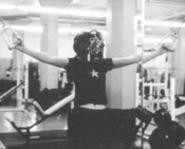Artists have always responded to changing facets of the contemporary landscape. Claude Monet took note of the Industrial Revolution with his paintings of the smoky Gare Saint Lazare train station. Here in Cleveland, during the '20s, Margaret Bourke-White helped to interpret the dynamism of the steel industry for the rest of the country. It's no different with the fitness craze that has taken off in the last couple of decades. Contemporary artists are finding that the gym is a rich source of material, and the new show at CCCA finds them striving to make sense of the fitness movement's impact.
New York curator Bill Arning suggests, in an essay accompanying the show, that all gyms implicitly tell their clients that, if they adhere to a strict workout schedule, they will never die. (The problem, says Arning, is that, as people get older and their health problems increase, they will no longer be able to do their workouts, and thus they will forfeit immortality by not going to the gym.) This is a modern spin on the Sisyphus story: You labor hard to build the perfect body, but it's never going to happen. Workout aficionados, Arning implies, are the new Sisyphuses: setting themselves to an impossible task.
The Sisyphus idea is familiar, but the curator adds an interesting wrinkle to it. In Greek mythology, Sisyphus was the double-dealing king of Corinth who was condemned, in Hades, to push a huge boulder up a hill. In accordance with the punishment, it would always roll down just as he reached the summit. Working out is presumably something people do because they want to do it. Maybe, though, it can be viewed as a punishment. Some of the machines, installations, and photographs in this show evoke torture devices, so the gym, instead of being a shrine to the body, might also be a place somewhere in hell, where people are condemned to fail when they think they've almost reached their goal. That is what the title of the show seems to be telling us -- on some level, people may be punishing themselves by continuing to frequent the gym.
Tom Cole's clever mixed-media installation called "Crash Diet" certainly suggests this situation. First, there is a clipboard on which we see dates at left and weight at right. Our mystery dieter fluctuates between 177 pounds and 212 pounds. Next, there is a computer-generated photo, which depicts, among other things, a distorted face. Finally, there is a talking head on a video screen, which babbles on about "underwater operations," "fitness levels," and "laser video games." If the dieter who obsessively records weight on the clipboard is also the talking head in the video clip, the message of the piece is that crash dieting is a good way to turn oneself into a raving lunatic. We are probably supposed to make something of the fact that the talking head wears headphones and runs on a treadmill (the sweat pouring down his face is the clincher): Maybe running on treadmills (not crash dieting) turns people into raving lunatics.
If "Crash Diet" was amusing and added a conceptual edge in the bargain, works like Lump Lipshitz's "Jockstrap Corner" have neither attribute. The work consists of -- you guessed it -- a bunch of jockstraps crammed into a corner of the gallery. Marcel Duchamp is dead, and it's about time contemporary artists took a break from spinning pathetic variations on his urinal-in-an-art-gallery idea. Also heavily Duchampian is Mungo Thompson's "Type A" -- three athletic cups hung on the wall. Work like this is not provocative or even shocking. It's just boring.
More effective is Cindy Gantz's witty "Sexercycle." It consists of a modified stationary bicycle and three photographs of the artist using it. (The photos document a performance piece that consisted of the artist using this machine in front of a live audience.) The bicycle is actually a mechanical device, and since it's turned on during the show, gallery-goers can see the handlebars flail wildly. In Woody Allen's movie Sleeper, we were introduced to the "orgasmatron," a device that enlivened dull parties in Allen's futuristic society. Like that machine, the "Sexercycle" promises a burst of pleasure for its users. Gantz situates the orgasmatron in the modern health club. So that's why membership at these places is soaring.
One of the more ambitious pieces in the show is Elizabeth Stephens's "Workout." Here, we have a piece that attempts to combine the Duchampian irreverence of "Jockstrap Corner" with the wittiness of "Sexercycle" and "Crash Diet." The result is stomach-turning. That would be fine if there were some insight to be had along with the distastefulness, but there isn't. The piece consists of 32 video monitors encased within a bunch of chrome-plated metal bars that resemble exercise machinery. Half of the video monitors show disembodied mouths swallowing things like pennies, Lego pieces, and plastic goldfish. The other monitors show the (same?) mouth spitting milk, the goldfish, and some marbles. The artist seems to be saying that there is something sexual about storing all these things up and then spitting them out. The metal bars suggest that the notion of tension and release is built into the mechanism of every workout machine, which adds to the sexual subtext. This work coasts by on its shock value. Unfortunately, that's all it has.
Artist Emily Richardson has her own take on the pervasive "looking" that takes place in today's health clubs. For her, the health club is a sculptural environment full of interesting objects, architectural features, and human bodies. Many photographers and documentary filmmakers speak of using the camera as a natural extension of their perceptions. Richardson takes this idea to its extreme by attaching a camera apparatus to her face (like a mask) and recording everything that goes on around her. The idea of the camera as a prosthetic device is an interesting one: A prosthesis replaces an insufficient body part or one that is not there at all. Perhaps the artist is telling us that, to see the gym clearly, we need the assistance of a camera. Photographs of Richardson doing a workout with her "prosthesis" are on view at the show (along with video footage that she took with it). The contraption also resembles a Halloween mask, and it makes Richardson look like some creature out of Star Wars.
This use of a mask-like mechanism adds another layer of complexity to Richardson's undertaking. Is the camera, in addition to being a prosthesis that can help us to see, also an instrument of aggression that turns its wearers into monsters? The work is suggesting that that may be the case. Perhaps, in the 1960 British cult film Peeping Tom, the main character -- who attaches a knife to the tripod of his camera and films his victims while they die -- is homicidal because he is a photographer. Maybe taking pictures is implicitly aggressive, because it allows us to freeze, and thus to kill, the object in front of us. Richardson's thought-provoking "Prosthetic Aesthetics" raises provocative questions about the nature of photography, and it's the strongest work in the show.
Even when Ted Williams hit for a league-leading .406 batting average in 1941, the "Splendid Splinter" did it in spite of failing to get a base hit in 60 percent of his at bats. Failure is built into the game of baseball. One can go far without achieving anything close to perfection. Unfortunately, the work in this show, with a few notable exceptions, like Richardson's fine conceptual piece, seems to proceed from the dubious premise that most Americans are fitness-obsessed people who spend their lives trying to achieve immortality in the gym. The idea about achieving failure (with its evocation of Sisyphus) is an interesting one, but unfortunately, the work in the show rarely repays close investigation.












